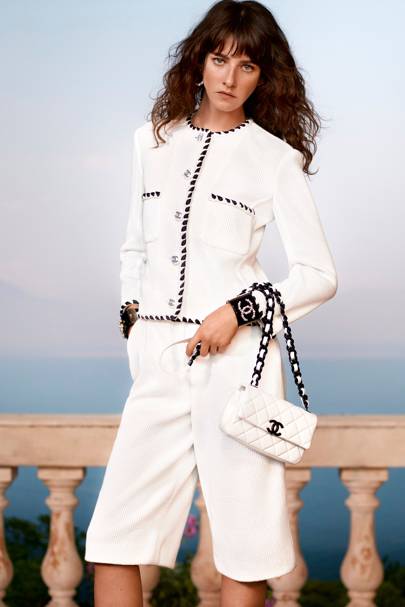The first major collection to launch since the coronavirus sent fashion into lockdown, today Chanel released its cruise proposal for a changed world. In place of the show – originally scheduled to take place in Capri on 7 May – photographers Karim Sadli and Julien Martinez Leclerc captured the collection in a series of atmospheric images and a film released on IGTV featuring the models Mica Argañaraz, Karly Loyce, Camille Hurel and Cris Herrmann, soundtracked to the track “Time”, amongst others by the Venezuelan artist and producer Arca. Titled Balade en Méditerranée – "a trip around the Mediterranean" – it featured a sunset-bathed seascape painted on a backdrop that wasn’t trying to pose as the real thing.
You could reflect on the current relatability of that illustration: we are all in the same digital boat, playing around with kitschy Zoom call backgrounds while dreaming ourselves away to sunny destinations. But before pandemics and lockdowns, Chanel already excelled in virtual reality, transforming the vast emptiness of the Grand Palais into a life-sized beach, a spaceship launch pad, a supermarket, and so on.
If those realist sets have often felt like a surreal trip around The Truman Show, overthinking this season’s digital experience could easily make your head spin. Rather than visiting a fabricated world – the way we would at the Grand Palais – we were witnessing a multi-layered experience: a fabricated world inside a digital world, seen from a real world, which doesn’t feel very real right now. Golly, let’s move on to the clothes.
While the limitations caused by the coronavirus have spawned a complicated industry debate about the future format of shows, it has largely simplified our fashion appetite. Concepts like wardrobe basics, investment pieces, expert craftsmanship and buying less but better became early reactions to the call for sustainability generated by the pandemic. (Fuelled, no doubt, by the fact we’ve all lived in sports and loungewear for two months now.) In every way, Virginie Viard’s collection was a manifestation of those values.

“We had to adapt,” she said in a statement, explaining how she decided to use stock materials for the collection, conceived from the idea of travelling light. It transpired in clarified takes on the Chanel suit in unlined leather or tweed, stripped of fuss and adornment bar big investment jewellery pieces handmade by Chanel’s artisans at Maison Desrues.
There was an emphasis on denim – the durable evergreen – patchworked with logos and florals. A two-piece set made up of a gridded halter-neck top and a flared matching trouser – worn with two-tone flats – distilled the codes of Chanel into ease and practicality. Often, it was expressed in a breezy 1970s silhouette: bandeau tops styled with flares, the midriff accentuated with chain and strap accessories or re-appropriated bandanas. All very feel-good.
Transformable pieces felt like an answer to anti-consumerism: skirts that double as strapless dresses, chiffon jackets that moonlight as dresses, embroidered long cardigans that could pass for mini dresses, and garments with a wealth of versatile styling options proposed by Viard in her collection notes.
Industry debates have called for elaborate cruise shows – i.e. pre- collections – to revert to their commercial raison d’être as toned-down frontrunners to the main collections. That wasn’t, of course, what Coco Chanel had in mind when she invented the cruise show in 1919, intended for clients who wintered in exotic locations and required fabulous capsule wardrobes.
Within the limits of trying times, Viard managed to unite the values of tradition and progression in a collection that felt appropriate for now. And, of course, send those of us trapped in our bedrooms a postcard from the fashion land of make-believe we so miss. Even if it was a down-to-earth one.
Industry debates have called for elaborate cruise shows – i.e. pre- collections – to revert to their commercial raison d’être as toned-down frontrunners to the main collections. That wasn’t, of course, what Coco Chanel had in mind when she invented the cruise show in 1919, intended for clients who wintered in exotic locations and required fabulous capsule wardrobes.
Within the limits of trying times, Viard managed to unite the values of tradition and progression in a collection that felt appropriate for now. And, of course, send those of us trapped in our bedrooms a postcard from the fashion land of make-believe we so miss. Even if it was a down-to-earth one.



No comments:
Post a Comment